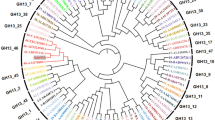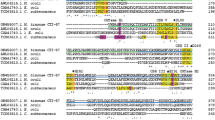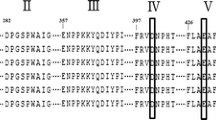Abstract
A gene (Tpen_1458) encoding a putative alpha amylase from hyperthermophilic archaeon Thermofilum pendens (TfMA) was cloned and expressed in Escherichia coli. The recombinant amylolytic enzyme was purified by Ni-NTA affinity chromatography and its catalytic properties were examined. Purified TfMA was extremely thermostable with a half-life of 60 min at an optimal temperature of 95°C. TfMA activity increased to 136% in the presence of 5 mM CaCl2. Maximal activity was measured toward γ-cyclodextrin with a specific activity of 56 U/mg using copper bicinchoninate method. TfMA catalyzed the ring-opening reaction by cleaving one α-1,4-glycosidic linkage of cyclodextrin to produce corresponding single maltooligosaccharide at the initial time. The final products from cyclodextrins, linear maltooligosaccharides, and starch were glucose and maltose, and TfMA could also degrade pullulan and amylase inhibitor acarbose to panose and acarviosine-glucose, respectively. These results revealed that TfMA is a novel maltogenic amylase.







Similar content being viewed by others
References
Altschul SF, Lipman DJ (1990) Protein database searches for multiple alignments. Proc Natl Acad Sci USA 87:5509–5513
Altschul SF, Madden TL, Schaffer AA, Zhang J, Zhang Z, Miller W, Lipman DJ (1997) Gapped BLAST and PSI-BLAST: a new generation of protein database search programs. Nucleic Acids Res 25:3389–3402
Anderson I, Rodriguez J, Susanti D, Porat I, Reich C, Ulrich LE, Elkins JG, Mavromatis K, Lykidis A, Kim E, Thompson LS, Nolan M, Land M, Copeland A, Lapidus A, Lucas S, Detter C, Zhulin IB, Olsen GJ, Whitman W, Mukhopadhyay B, Bristow J, Kyrpides N (2008) Genome sequence of Thermofilum pendens reveals an exceptional loss of biosynthetic pathways without genome reduction. J Bacteriol 190:2957–2965
Auh JH, Chae HY, Kim YR, Shim KH, Yoo SH, Park KH (2006) Modification of rice starch by selective degradation of amylose using alkalophilic Bacillus cyclomaltodextrinase. J Agric Food Chem 54:2314–2319
Bradford MM (1976) A rapid and sensitive method for the quantitation of microgram quantities of protein utilizing the principle of protein-dye binding. Anal Biochem 72:248–254
Buedenbender S, Schulz GE (2009) Structural base for enzymatic cyclodextrin hydrolysis. J Mol Biol 385:606–617
Cha HJ, Yoon HG, Kim YW, Lee HS, Kim JW, Kweon KS, Oh BH, Park KH (1998) Molecular and enzymatic characterization of novel maltogenic amylase that hydrolyzes and transglycosylates acarbose. Eur J Biochem 253:251–262
Cheong KA, Kim TJ, Yoon JW, Park CS, Lee TS, Kim YB, Park KH, Kim JW (2002) Catalytic activities of intracellular dimeric neopullulanase on cyclodextrin, acarbose and maltose. Biotechnol Appl Biochem 35:27–34
Cheong KA, Tang S, Cheong TK, Cha H, Kim JW, Park KH (2005) Thermostable and alkalophilic maltogenic amylase of Bacillus thermoalkalophilus ET2 in monomer–dimer equilibrium. Biocatal Biotransformation 23:79–87
Copeland A, Lucas S, Lapidus A, Barry K, Detter JC, Glavina del Rio, Dalin E, Tice H, Pitluck S, Thompson LS, Brettin T, Bruce D, Han C, Tapia R, Schmutz J, Larimer F, Land M, Hauser L, Kyrpides N, Kim E, Anderson I, Olsen G, Reich C, Woese C, Richardson P (2006) Complete sequence of Chromosome1 of Thermofilum pendens Hrk 5. http://www.ncbi.nlm.nih.gov/entrez/viewer.fcgi?db=nuccore&id=119718918. Accessed 3 Mar 2007
Fox JD, Robyt JF (1991) Miniaturization of three carbohydrate analyses using a microsample plate reader. Anal Biochem 195:93–96
Hashimoto Y, Yamamoto T, Fujiwara S, Takagi M, Imanaka T (2001) Extracellular synthesis, specific recognition, and intracellular degradation of cyclomaltodextrins by the hyperthermophilic archaeon Thermococcus sp. strain B1001. J Bacteriol 183:5050–5057
Henrissat B (1991) A classification of glycosyl hydrolases based on amino-acid sequence similarities. Biochem J 280:309–316
Jones A, Lamsa M, Frandsen TP, Spendler T, Harris P, Sloma A, Xu F, Nielsen JB, Cherry JR (2008) Directed evolution of a maltogenic alpha-amylase from Bacillus sp. TS-25. J Biotechnol 134:325–333
Kamasaka H, Sugimoto K, Takata H, Nishimura T, Kuriki T (2002) Bacillus stearothermophilus neopullulanase selective hydrolysis of amylose to maltose in the presence of amylopectin. Appl Environ Microbiol 68:1658–1664
Kim TJ, Kim MJ, Kim BC, Kim JC, Cheong TK, Kim JW, Park KH (1999) Modes of action of acarbose hydrolysis and transglycosylation catalyzed by a thermostable maltogenic amylase, the gene for which was cloned from a Thermus strain. Appl Environ Microbiol 65:1644–1651
Kim YW, Choi JH, Kim JW, Park C, Kim JW, Cha H, Lee SB, Oh BH, Moon TW, Park KH (2003) Directed evolution of Thermus maltogenic amylase toward enhanced thermal resistance. Appl Environ Microbiol 69:4866–4874
Kim JW, Kim YH, Lee HS, Yang SJ, Kim YW, Lee MH, Kim JW, Seo NS, Park CS, Park KH (2007) Molecular cloning and biochemical characterization of the first archaeal maltogenic amylase from the hyperthermophilic archaeon Thermoplasma volcanium GSS1. Biochim Biophys Acta 1774:661–669
Laemmli UK (1970) Cleavage of structural proteins during the assembly of the head of bacterio-phage T4. Nature 227:680–685
Larkin MA, Blackshields G, Brown NP, Chenna R, McGettigan PA, McWilliam H, Valentin F, Wallace IM, Wilm A, Lopez R, Thompson JD, Gibson TJ, Higgins DG (2007) Clustal W and Clustal X version 2.0. Bioinformatics 23:2947–2948
Lee HS, Kim MS, Cho HS, Kim JI, Kim TJ, Choi JH, Park C, Lee HS, Oh BH, Park KH (2002a) Cyclomaltodextrinase, neopullulanase, and maltogenic amylase are nearly indistinguishable from each other. J Biol Chem 277:21891–21897
Lee MH, Kim YW, Kim TJ, Park CS, Kim JW, Moon TW, Park KH (2002b) A novel amylolytic enzyme from Thermotoga maritima, resembling cyclodextrinase and α-glucosidase, that liberates glucose from the reducing end of the substrates. Biochem Biophys Res Commun 295:818–825
Miller GL (1959) Use of dinitrosalycylic acid reagent for determination reducing sugar. Anal Chem 31:426–428
Page RDM (1996) TREEVIEW: an application to display phylogenetic trees on personal computers. Comput Appl Biosci 12:357–358
Robyt JF, Mukerjea R (1994) Separation and quantitative determination of nanogram quantities of maltodextrins and isomaltodextrins by thin-layer chromatography. Carbohydr Res 251:187–202
Tonozuka T, Ohtsuka M, Mogi S, Sakai H, Ohta T, Sakano Y (1993) A neopullulanase-type alpha-amylase gene from Thermoactinomyces vulgaris R-47. Biosci Biotechnol Biochem 57:395–401
Unsworth LD, van der Oost J, Koutsopoulos S (2007) Hyperthermophilic enzymes—stability, activity and implementation strategies for high temperature applications. FEBS J 274:4044–4056
Vieille C, Zeikus GJ (2001) Hyperthermophilic enzymes: sources, uses, and molecular mechanisms for thermostability. Microbiol Mol Biol Rev 65:1–43
Yang SJ, Lee HS, Park CS, Kim YR, Moon TW, Park KH (2004) Enzymatic analysis of an amylolytic enzyme from the hyperthermophilic archaeon Pyrococcus furiosus reveals its novel catalytic properties as both an alpha-amylase and a cyclodextrin-hydrolyzing enzyme. Appl Environ Microbiol 70:5988–5995
Yang SJ, Lee HS, Kim JW, Lee MH, Auh JH, Lee BH, Park KH (2006) Enzymatic preparation of maltohexaose, maltoheptaose, and maltooctaose by the preferential cyclomaltooligosaccharide (cyclodextrin) ring-opening reaction of Pyrococcus furiosus thermostable amylase. Carbohydr Res 341:420–424
Zillig W, Gierl A, Schreiber G, Wunderl S, Janekovic D, Stetter KO, Klenk HP (1983) The archaebacterium Thermofilum pendens represents a novel genus of the thermophilic, anaerobic sulfur respiring Thermoproteales. Syst Appl Microbiol 4:79–87
Acknowledgments
This project was sponsored in part by the Scientific Research Foundation for the Returned Overseas Chinese Scholars, State Education Ministry, and a Research Grant from Jilin Province Government (20080253).
Author information
Authors and Affiliations
Corresponding author
Rights and permissions
About this article
Cite this article
Li, X., Li, D., Yin, Y. et al. Characterization of a recombinant amylolytic enzyme of hyperthermophilic archaeon Thermofilum pendens with extremely thermostable maltogenic amylase activity. Appl Microbiol Biotechnol 85, 1821–1830 (2010). https://doi.org/10.1007/s00253-009-2190-6
Received:
Revised:
Accepted:
Published:
Issue Date:
DOI: https://doi.org/10.1007/s00253-009-2190-6




